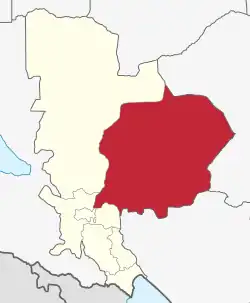Mbarali District
Mbarali District is one of the seven districts of Mbeya Region, Tanzania. It is bordered to the north by Iringa region and east by Njombe region. To the south the district is bordered by Mbeya Rural District and to the west by Chunya District.
Mbarali | |
|---|---|
 Mbarali District of Mbeya Region | |
| Coordinates: 08°04′S 34°38′E | |
| Country | |
| Region | Mbeya Region |
| District | Mbarali District |
| Headquarters | Rujewa |
| Government | |
| • Type | Council |
| • Chairman[1] | Twalib Tamimu Lubandamo |
| • Director[1] | Missana Kalela Kwangura |
| Population | |
| • Total | 300,517 |
| • Religion | Christianity |
| Time zone | EAT |
| Postcode[3] | 536xx |
| Area code | 025 |
| Website | District Website |
In 2016 the Tanzania National Bureau of Statistics report there were 331,206 people in the district, from 300,517 in 2012.[2]: 97 [4]: 118
Mbarali district is the most famous area for rice farming. The district is home to Kapunga rice project and Mbarali estate. The district hosts a very famous wetland called Ihefu, as well as the Usangu plain. Ruaha National Park is within the district to the north side.
Wards
The Mbarali District is administratively divided into 20 wards:
Education and transportation
In the case of education, Mbarali district has several public and private schools in both primary and secondary levels. The famous schools like St Ann's and Montfort are within the district. Also an advanced level secondary school called Madibira high school is within the district. TANZAM-HIGHWAY passes in the southern part of the district. The road links the towns of Igawa, Chimala and Igurusi with the cities of Dar es Salaam and Mbeya as well as the neighbouring countries like Malawi and Zambia. A railway line called TAZARA which connects the two countries Tanzania and Zambia, runs in the district.
References
- "Halmashauri ya Wilaya ya Mbarali" (in Swahili). Mbarali District. Archived from the original on 21 August 2022. Retrieved 7 September 2022.
- 2016 Makadirio ya Idadi ya Watu katika Majimbo ya Uchaguzi kwa Mwaka 2016, Tanzania Bara [Population Estimates in Administrative Areas for the Year 2016, Mainland Tanzania] (PDF) (Report) (in Swahili). Dar es Salaam, Tanzania: National Bureau of Statistics. 1 April 2016. Archived (PDF) from the original on 27 December 2021. Retrieved 3 July 2022.
- "Mbeya Postcodes" (PDF). Tanzania Communications Regulatory Authority. Archived (PDF) from the original on 9 August 2022. Retrieved 18 August 2022.
- 2012 Population and Housing Census - Population Distribution by Administrative Areas (PDF) (Report). Dar es Salaam, Tanzania: National Bureau of Statistics. 1 March 2013. Archived (PDF) from the original on 26 March 2022. Retrieved 3 July 2022.